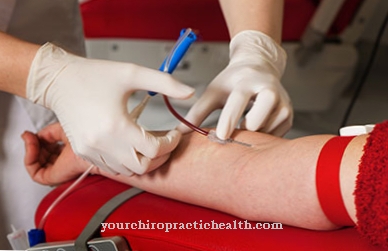A Testicular torsion, so the Twisting of the testicle and the associated structures, such as the spermatic cord, is an extremely painful affair. Infants and young children are primarily affected, but testicular torsion can also occur suddenly in adulthood.
What is testicular torsion?
.jpg)
© 4th Life Photography - stock.adobe.com
At a Testicular torsion The testicles and spermatic cord twist around their own longitudinal axis. This leads to an interruption in the supply of the vessels in the testes, which means that they are no longer adequately supplied with oxygen and can die within a few hours. A testicular torsion could therefore also be described as an infarction of the testicle.
The extent and severity of the twist determine how long blood can flow through the testicle without dying.Since the symptoms of testicular torsion can easily be confused with those of acute inflammation of the epididymis, i.e. so-called epididymitis, it should be determined as quickly as possible which of the two is really present.
causes
The main reason that, for the most part, infants and toddlers from one Testicular torsion are affected is a relatively rare malformation of the testicular sheaths.
These are then not sufficiently fused together, so that even one wrong movement by the child, for example while climbing or riding a bike, can be enough to cause testicular torsion.
Furthermore, an anomaly in the development of the spermatic cord can also promote testicular torsion. But even without the presence of such malformations, the testicle can unhappily twist.
Often, jerky and unnatural movements during sports or the result of an accident or injury are the trigger. In addition, around half of testicular torsions occur with involuntary movements while sleeping.
Symptoms, ailments & signs
The most distinctive symptom of testicular torsion is severe pain on the affected side of the scrotum. These usually occur suddenly and often at night. In rare cases, the symptoms can only be noticed slowly. There is a risk of confusion with epididymitis. The pain can radiate over the entire scrotum and subsequently also over the groin and lower abdomen.
The symptoms are sometimes accompanied by vegetative complaints such as an accelerated heart rate up to shock, nausea, vomiting and dizziness. There may also be a marked reddening of the affected area. The testicle often swells and may be high. In some cases, there are multiple incomplete torsions, in which the affected testicle turns back on its own.
Symptoms therefore only appear for a short time and then disappear again. Affected infants experience abdominal pain, umbilical colic, refusal to eat and motor restlessness. Usually they cannot be calmed down at all. Testicular torsion is not easy to diagnose in them because it often begins insidiously. A twisting of the testicle is difficult to recognize, even in those with undescended testicles. They can have diffuse symptoms that can resemble those of appendicitis.
Diagnosis & course
A Testicular torsion manifests itself in a mostly suddenly occurring severe pain in the testicles and groin area, which can radiate into the abdomen. The abdominal pain is often so severe that it can lead to nausea and vomiting.
The affected testicle is usually high, swelling and the scrotum turns red. In infants, on the other hand, the course is often more insidious and does not express itself nearly as strongly and clearly. Therefore, as a precaution, one should have a pediatrician rule out testicular torsion in crying babies who cannot be calmed down.
Since these symptoms can also indicate inflammation of the epididymis, a urologist should be seen immediately to determine the exact nature of the disease. Testicular torsion can be diagnosed very quickly by examining the lower abdomen and the groin area.
It is also checked whether the pain is increased by lifting the testicle. In addition, an ultrasound examination of the testicle is usually carried out in order to find out whether the blood is still circulating. If left untreated, testicular torsion often leads to the death of the affected testicle within hours.
Complications
Testicular torsion is usually associated with extremely severe pain for the patient. The pain also occurs after the torsion and can continue to lead to a loss of consciousness. If the person loses consciousness, he or she may be injured by falling. The testicles also usually swell and turn red in color.
Furthermore, the pain spreads to other areas of the body due to testicular torsion and thus restricts the movement of the person concerned. Abdominal pain can also occur. It is not uncommon for the patient to suffer from vomiting and nausea. Testicular torsion can be treated with surgery. However, this procedure is only possible if the testicle is not completely dead.
If it comes to complete death, no further treatment is possible and it must be removed. Usually there are no other complaints. However, should it die, this can lead to an inability to conceive, which is often associated with psychological complaints. Testicular torsion can also limit the production of hormones.
When should you go to the doctor?
If you notice testicular pain after an accident or fall, you may have testicular torsion. This is a medical emergency, so the person affected should consult a doctor immediately. In the event of severe complaints, the person affected must be taken to the nearest hospital. Typical warning signs that require immediate clarification are severe pain that radiates into the groin and visible reddening of the testicles, often associated with nausea and vomiting.
In babies, testicular torsion often manifests itself as abdominal pain and umbilical colic. Medical advice is required if these symptoms are noticed. This is especially true if the symptoms are due to a specific cause such as a bicycle accident or a fall while climbing. The affected person should speak to their family doctor or urologist immediately. The medical emergency service can provide first aid measures and help the person concerned with further steps. Since untreated testicular torsion can cause permanent damage, it is important to react quickly.
Doctors & therapists in your area
Treatment & Therapy
As soon as a Testicular torsion has been diagnosed beyond doubt, immediate emergency surgery of the testicle is essential. There is no other way to save the affected testicle from dying in time.
If the testicle has not yet died, it is immediately turned back into its original and natural position so that it can be adequately supplied with blood again. Then both the affected and the healthy testicle are fixed to the scrotum in order to avoid repeated testicular torsion.
If it is too late to restore the initial position and the twisted testicle has already died, it must at least be removed and the remaining healthy testicle sewn to the scrotum to prevent the torsion from recurring in this testicle as well.
The removed testicle can then be replaced with a silicone implant. The fertility and the production of hormones are usually guaranteed even with only one remaining testicle.
You can find your medication here
➔ Medicines for painOutlook & forecast
Testicular torsion usually starts with mild pain, but it gets worse quickly. Affected patients usually only need a few days before they consult a doctor on their own because of the pain. Since testicular torsion is a lack of blood supply to a part of the body, it can quickly develop into a life-threatening condition if left untreated. If a testicular torsion is not noticed in time, the affected testicle dies, releasing toxins that can increase to blood poisoning.
If, on the other hand, the condition is detected early on, it may still be possible to save the testicle through an operation. If the damage is too great, the twisted testicle must be removed, but the other one remains and the patient is thus able to procreate. If a testicle has been removed, a prosthesis is inserted, which the patient does not notice much. It ensures that the scrotum continues to look like it did before from the outside.
If both testicles are affected by a torsion, the patient can lose his fertility during the vital surgical procedure, depending on the progress of the disease. Of course, we always try to preserve the testicle as much as possible. In addition, the patient is informed about possible complications and consequential damage before the operation.
prevention
The most important thing when you suspect one Testicular torsion is the quick diagnosis and treatment. As a result, you should immediately consult a urologist or drive straight to the hospital if you experience the symptoms described, as every minute can be precious. Direct prevention is not possible.
Aftercare
If the testicle is twisted, in most cases there are few or no direct follow-up measures available to the patient. The person concerned must primarily have this complaint treated by a doctor so that there are no further complications or complaints. In some cases, twisting the testicle can lead to infertility.
A doctor should therefore be contacted at the first sign of this complaint. In some cases, surgery is necessary if a testicle has died. The procedure itself usually runs without complications. Then the person concerned should rest and take care of his body.
The activity that has caused the testicle to twist should be avoided. If this condition leads to male infertility, some patients need psychological treatment. Conversations with your own family or with your partner can also be very helpful and prevent depression or other psychological upsets. The life expectancy of the person affected is not reduced by this disease if it is recognized and treated early enough.
You can do that yourself
There are no self-help measures in the event of complete testicular torsion. Under no circumstances should you try to move the testicle back into the correct position with your own hands or other aids if you suspect a torsion. Calling an ambulance is more appropriate.
In the common case of partially running testicular torsion, which regresses and can trigger pain, it can help to loosely position the testicle afterwards. Excessive warming or cooling that may help with pain is critical in the testicle area. These react extremely sensitively to temperature fluctuations - among other things with movement through the corresponding muscles. This can worsen a partially existing rotation, which is why a visit to the doctor is preferable.
If testicular torsion has occurred and surgically corrected, it is important to position the testicle properly for the time being. Special testicular rests and special seat pads can help in everyday life, reduce the risk of pain and facilitate the healing process. Moderate cooling is appropriate. People who, due to their testicular torsion, fear that their fertility will be severely restricted should be provided with information accordingly. The knowledge that fertility is still given with one testicle also helps in the case of a removed testicle as a result of testicular torsion.


.jpg)

.jpg)



















.jpg)



